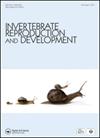虾青素在大龙虾体内的分布:生物周期的变化趋势
IF 0.8
4区 生物学
Q4 REPRODUCTIVE BIOLOGY
引用次数: 1
摘要
摘要采用反相高压液相色谱法对南非刺龙虾(Jasus lalandii)血淋巴和组织提取物中的虾青素(Astaxanthin)进行了定量分析,并对成虫的生长和繁殖周期进行了分析。在将这些动物从海洋中移出的几天内,收集了两性的血淋巴、外骨骼、肌肉、性腺和肝胰脏,以及浆果雌性的卵包。因此,虾青素是野生龙虾的代表。虾青素在外骨骼、卵巢和卵包中的含量明显更高,受雌性卵巢周期的影响:虾青素在生长中的卵母细胞中积累,并留在挤出的卵中,表面上作为抗氧化剂起到保护作用。用放射性菊粉测定了刺龙虾的总血淋巴体积,并测量了身体器官和各种组织对这些动物总重量的重量贡献:肌肉组织占拉兰迪龙虾总湿重的33%,而血淋巴(22%)和外骨骼(20%)是其他主要贡献者。因此,为了最大限度地从尸体中获取虾青素,最好只关注外骨骼,重点放在甲壳上,因为甲壳很容易去除。本文章由计算机程序翻译,如有差异,请以英文原文为准。
Distribution of astaxanthin in the spiny lobster Jasus lalandii: trends during biological cycles
ABSTRACT Astaxanthin, the dominant carotenoid pigment in the South African spiny lobster, Jasus lalandii, was quantified in haemolymph and tissue extracts by means of reverse phase-high pressure liquid chromatography and analysed with respect to growth and reproduction cycles of adults. Haemolymph, exoskeleton, muscle, gonads and hepatopancreas from both sexes, as well as egg parcels from berried females were collected within days of removing the animals from the ocean. The astaxanthin profile is, therefore, representative of spiny lobsters in the wild. Astaxanthin is significantly more in exoskeleton, ovaries and egg parcels, and is influenced by the ovarian cycle in females: it accumulated in growing oocytes and remained in the extruded eggs ostensibly for protection as antioxidant. Radioactive inulin was used to determine total haemolymph volume of a spiny lobster and the gravimetric contribution of body organs and various tissues to the total weight of these animals were measured: muscle tissue constitutes 33% of the total wet weight of J. lalandii, while haemolymph (22%) and exoskeleton (20%) are other major contributors. For maximal harvesting of astaxanthin from carcases, it would thus, be best to focus only on the exoskeleton with an emphasis on the carapace, which can be easily removed.
求助全文
通过发布文献求助,成功后即可免费获取论文全文。
去求助
来源期刊
CiteScore
1.90
自引率
0.00%
发文量
21
审稿时长
>12 weeks
期刊介绍:
Invertebrate Reproduction & Development ( IRD) presents original research on the reproductive and developmental biology of the Invertebrata, both embryonic and postembryonic. IRD welcomes papers reporting significant results obtained using new techniques. Encouraged topic areas include: aquaculture, physiology, biochemistry, functional morphology, phylogeny, behavioural and regulatory mechanisms, including genetic, endocrine and molecular studies. Papers containing qualitative descriptions of reproductive cycles and gametogenesis will not be considered. IRD is published in association with the International Society of Invertebrate Reproduction and Development.

 求助内容:
求助内容: 应助结果提醒方式:
应助结果提醒方式:


